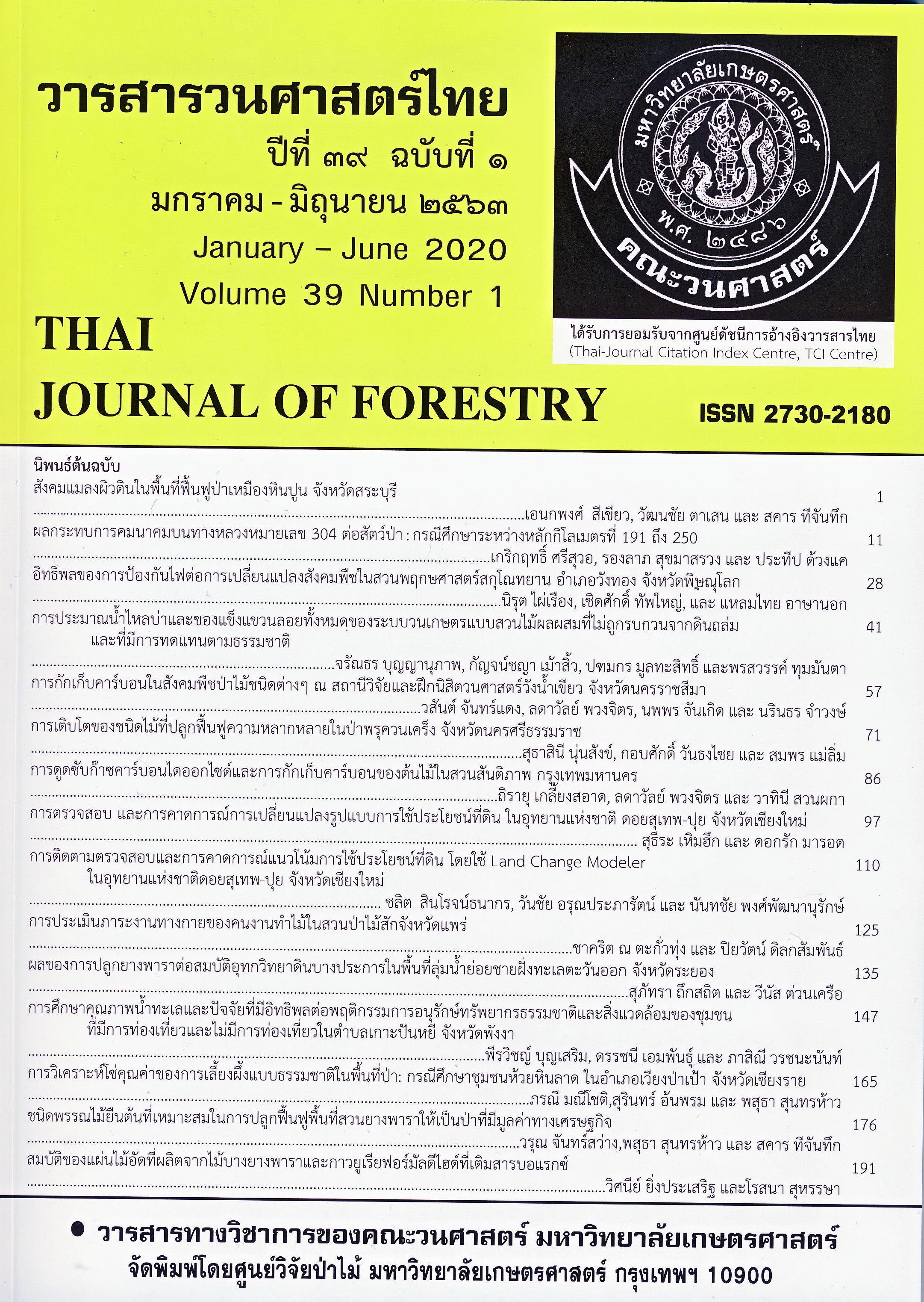สมบัติของแผ่นไม้อัดที่ผลิตจากไม้บางยางพาราและกาวยูเรียฟอร์มัลดีไฮด์ที่เติมสารบอแรกซ์
Main Article Content
บทคัดย่อ
การทดลองนี้ได้ทำการศึกษาผลของการเติมสารบอแรกซ์ลงในกาวยูเรียฟอร์มัลดีไฮด์ในปริมาณร้อยละ 5, 10 และ 15 ของน้ำหนักเนื้อกาวแห้งต่อสมบัติของกาว ความต้านแรงเฉือน ปริมาณการระเหยของฟอร์มัลดีไฮด์ ความต้านทานต่อการเข้าทำลายของเชื้อราผุสีขาว (Trametes versicolor) เชื้อราผุสีน้ำตาล (Gloeophyllum striatum) และความต้านทานการเข้าทำลายของปลวกใต้ดิน (Coptotermes gestroi) ของแผ่นไม้อัดที่ผลิตจากไม้บางยางพาราและกาวยูเรียฟอร์มัลดีไฮด์ผสมสารบอแรกซ์ เปรียบเทียบสมบัติเหล่านี้กับแผ่นไม้อัดที่ผลิตจากไม้บางยางพาราและกาวยูเรียฟอร์มัลดีไฮด์ ผลการทดลองพบว่า การเติมสารบอแรกซ์ในกาวยูเรียฟอร์มัลดีไฮด์ทำให้ค่าพีเอช (pH) ของกาวเป็นด่าง หากเติมสารบอแรกซ์ในปริมาณมากพอ (ร้อยละ 10-15 ของน้ำหนักเนื้อกาวแห้ง) ทำให้ระยะเวลาที่กาวเปลี่ยนสถานะจากของเหลวเป็นเจล (gel time) สั้นลง แผ่นไม้อัดที่ผลิตจากไม้บางยางพาราและใช้กาวยูเรียฟอร์มัลดีไฮด์เติมสารบอแรกซ์ ร้อยละ 10-15 ของน้ำหนักเนื้อกาวแห้ง มีปริมาณการระเหยของฟอร์มัลดีไฮด์ลดลง ความต้านทานต่อการเข้าทำลายของเชื้อราผุสีขาวและเชื้อราผุสีน้ำตาล ความต้านทานต่อการเข้าทำลายของปลวกใต้ดินเพิ่มขึ้น และหากเติมสารบอแรกซ์ลงในกาวยูเรียฟอร์มัลดีไฮด์ร้อยละ 15 ของน้ำหนักเนื้อกาวแห้ง มีผลทำให้แผ่นไม้อัดที่ผลิตจากไม้บางยางพารามีความต้านแรงเฉือนเพิ่มขึ้นด้วย
Downloads
Article Details
ข้าพเจ้าและผู้เขียนร่วม (ถ้ามี) ขอรับรองว่า ต้นฉบับที่เสนอมานี้ยังไม่เคยได้รับการตีพิมพ์และไม่ได้อยู่ในระหว่างกระบวนการพิจารณาตีพิมพ์ลงในวารสารหรือสิ่งตีพิมพ์อื่นใด ข้าพเจ้าและผู้เขียนร่วม (ถ้ามี) ยอมรับหลักเกณฑ์และเงื่อนไขการพิจารณาต้นฉบับ ทั้งยินยอมให้กองบรรณาธิการมีสิทธิ์พิจารณาและตรวจแก้ต้นฉบับได้ตามที่เห็นสมควร พร้อมนี้ขอมอบลิขสิทธิ์ผลงานที่ได้รับการตีพิมพ์ให้แก่วารสารวนศาสตร์ คณะวนศาสตร์ มหาวิทยาลัยเกษตรศาสตร์ กรณีมีการฟ้องร้องเรื่องการละเมิดลิขสิทธิ์เกี่ยวกับภาพ กราฟ ข้อความส่วนใดส่วนหนึ่ง หรือ ข้อคิดเห็นที่ปรากฏในผลงาน ให้เป็นความรับผิดชอบของข้าพเจ้าและผู้เขียนร่วม (ถ้ามี) แต่เพียงฝ่ายเดียว และหากข้าพเจ้าและผู้เขียนร่วม (ถ้ามี) ประสงค์ถอนบทความในระหว่างกระบวนการพิจารณาของทางวารสาร ข้าพเจ้าและผู้เขียนร่วม (ถ้ามี) ยินดีรับผิดชอบค่าใช้จ่ายทั้งหมดที่เกิดขึ้นในกระบวนการพิจารณาบทความนั้น”
เอกสารอ้างอิง
American Society for Testing and Materials [ASTM]. 1999. Standard Test Method for Laboratory Evaluation of Wood and Other Cellulosic Materials for Resistance to Termites. ASTM D 3345-74 (Reapproved 1999).
American Society for Testing and Materials [ASTM]. 2007. Standard Test Method for Wood Preservatives by Laboratory Soil-Block Cultures. ASTM D1413-07e1.
British Standards Institution. 1996. BS EN 717-3:1996 Wood-based panels - Determination of formaldehyde release. Formaldehyde release by the flask method. London.
Boran, S., M. Usta, S. Ondaral and E. Gümüşkaya. 2012. The efficiency of tannin as a formaldehyde scavenger chemical in medium density fiberboard. Composites Part B: Engineering 43(5): 2487-2491.
Colak, S. and G. Colakoglu. 2004. Volatile acetic acid and formaldehyde emission from plywood treated with boron compound. Building and Environment 39(5): 533-536.
Çolakoğlu, G. and C. Demirkir. 2006. Characteristics of plywood panels produced with urea formaldehyde resin (UF) containing borax. Holz als Roh- und Werkstoff 64(3): 250-251.
Japanese Standards Association. 1994. General testing methods for adhesives. JIS K 6833:1994.
Kartal, S.N. and N. Ayrilmis. 2005. Blockboard with boron-treated veneers: Laboratory decay and termite resistance tests. International Biodeterioration & Biodegradation 55(2): 93-98.
Kartal, S.N. and Y. Imamura. 2007. Decay and termite resistance of plywood treated with various fire retardants. Building and Environment 42(3): 1207-1211.
Lesar, B., A. Ugovšek, M. Kariž, M. Šernek and M. Humar. 2011. Influence of boron compounds in adhesives on the bonding quality and fungicidal properties of wood. Wood Research 56(3): 285-296.
Özçifçi, A. 2008. Impacts of impregnation with boron compounds on the bonding strength of wood material. Construction and Building Materials 22(4): 541-545.
Sensogut, C., M. Ozalp and H. Yesil. 2009. The effect of boric acid pentahydrate addition to urea formaldehyde on the mechanical characteristics and free formaldehyde content of plywood. International Journal of Adhesion & Adhesives 29: 589-592.
Teoh, Y.P., M.M. Don and S. Ujang. 2011. Assessment of the properties, utilization, and preservation of rubberwood (Hevea brasiliensis): a case study in Malaysia. Journal of Wood Science 57: 255-266.
Thai Industrial Standards Institute [TISI]. 2006. Veneer Plywood. TIS 178-2549. (in Thai)
Vishnuvarthanan, M. and N. Rajeswari. 2013. Additives for enhancing the drying properties of adhesives for corrugated boards. Alexandria Engineering Journal 52(1): 137-140.
Xing, C., S.Y. Zhang, J. Deng. and S. Wang. 2007. Urea-formaldehyde-resin gel time as affected by the pH value, solid content, and catalyst. Journal of Applied Polymer Science 103(3): 1566-1569.
Yanjuan, W., F. Yanxiong, T. Wei and L. Chunying. 2013. Preservation of aged paper using borax in alcohols and the supercritical carbon dioxide system. Journal of Cultural Heritage 14: 16-22.


